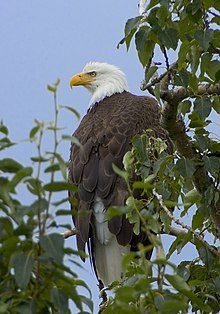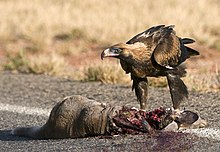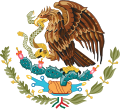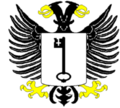Eagle
From Wikipedia, the free encyclopedia
(Redirected from Eagles)
This article is about the bird. For other uses, see Eagle (disambiguation).
| Eagle | |
|---|---|
 | |
| Bald Eagle | |
| Scientific classification | |
| Kingdom: | Animalia |
| Phylum: | Chordata |
| Class: | Aves |
| Order: | Falconiformes ( or Accipitriformes, q.v.) |
| Family: | Accipitridae |
| Genera | |
Several, see text | |
Eagles are members of the bird family Accipitridae, and belong to several genera which are not necessarily closely related to each other. Most of the more than 60 species occur in Eurasia and Africa.[1] Outside this area, just two species (the Bald and Golden Eagles) can be found in the United States and Canada, nine more in Central and South America, and three in Australia.
Description
Eagles differ from many other birds of prey[which?] mainly by their larger size, more powerful build, and heavier head and beak. Even the smallest eagles, like the Booted Eagle (which is comparable in size to a Common Buzzard or Red-tailed Hawk), have relatively longer and more evenly broad wings, and more direct, faster flight[who?]. Most eagles are larger than any other raptors apart from the vultures. Species named as eagles range in size from the South Nicobar Serpent-eagle, at 500 g (1.1 lb) and 40 cm (16 in), to the 6.7 kg (14.7 lbs) Steller's Sea Eagle and the 100 cm (39 in) Philippine Eagle. Like all birds of prey, eagles have very large hooked beaks for tearing flesh from their prey, strong muscular legs, and powerful talons. They also have extremely keen eyesight which enables them to spot potential prey from a very long distance.[2] This keen eyesight is primarily contributed by their extremely large pupils which ensure minimal diffraction (scattering) of the incoming light.
Eagles build their nests, called eyries, in tall trees or on high cliffs. Many species lay two eggs, but the older, larger chick frequently kills its younger sibling once it has hatched. The dominant chick tends to be the female, as they are bigger than the male. The parents take no action to stop the killing.
[edit]Species
Major new research into eagle taxonomy suggests that the important genera Aquila andHieraaetus are not composed of nearest relatives, and it is likely that a reclassification of these genera will soon take place, with some species being moved to Lophaetus or Ictinaetus.[3]
- Bonelli's Eagle, the Booted Eagle and the Little Eagle have been moved from Hieraaetus toAquila.
- Either the Greater Spotted Eagle and Lesser Spotted Eagle should move from Aquila to join theLong-crested Eagle in Lophaetus, or, perhaps better, all three of these species should move toIctinaetus with the Black Eagle.
- The Steppe Eagle and Tawny Eagle, once thought to be conspecific, are not even each other's nearest relatives.
FAMILY ACCIPITRIDAE
- Subfamily Buteoninae - hawks (buzzards), true eagles and sea-eagles
- Genus Geranoaetus
- Black-chested Buzzard-eagle, Geranoaetus melanoleucus
- Genus Harpyhaliaetus
- Crowned Solitary Eagle, Harpyhaliaetus coronatus
- Solitary Eagle, H. solitarius
- Genus Morphnus
- Crested Eagle, Morphnus guianensis
- Genus Harpia
- Harpy Eagle, Harpia harpyja
- Genus Pithecophaga
- Philippine Eagle, Pithecophaga jefferyi
- Genus Harpyopsis
- New Guinea Eagle, Harpyopsis novaeguineae
- Genus Oroaetus
- Black-and-chestnut Eagle, Oroaetus isidori
- Genus Spizaetus
- Cassin's Hawk-eagle, Spizaetus africanus
- Changeable Hawk-eagle, S. cirrhatus
- Mountain Hawk-eagle, S. nipalensis
- Blyth's Hawk-eagle, S. alboniger
- Javan Hawk-eagle, S. bartelsi
- Sulawesi Hawk-eagle, S. lanceolatus
- Philippine Hawk-eagle, S. philippensis
- Wallace's Hawk-eagle, S. nanus
- Black Hawk-eagle, S. tyrannus
- Ornate Hawk-eagle, S. ornatus
- Black-and-white Hawk-eagle, S. melanoleucus
- Genus Lophaetus
- Long-crested Eagle, Lophaetus occipitalis - possibly belongs in Ictinaetus
- Genus Stephanoaetus
- Crowned Hawk-eagle, Stephanoaetus coronatus
- Genus Polemaetus
- Martial Eagle, Polemaetus bellicosus
- Genus Hieraaetus
- Ayres' Hawk-eagle, Hieraaetus ayresii
- African Hawk Eagle, H. spilogaster
- New Guinea Hawk-eagle, H. weiskei
- Genus Harpagornis (extinct)
- Haast's Eagle, †Harpagornis moorei - possibly belongs in either Hieraaetus or Aquila[4]
- Genus Aquila
- Bonelli's Eagle, Aquila fasciata - formerly Hieraaetus fasciatus
- Booted Eagle, A. pennata - formerly Hieraaetus pennatus
- Little Eagle, A. morphnoides
- Golden Eagle, A. chrysaetos
- Eastern Imperial Eagle, A. heliaca
- Rufous-bellied Eagle, A. kienerii
- Spanish Imperial Eagle A. adalberti
- Steppe Eagle, A. nipalensis
- Tawny Eagle, A. rapax
- Greater Spotted Eagle, A. clanga - to be moved to Lophaetus or Ictinaetus
- Lesser Spotted Eagle, A. pomarina - to be moved to Lophaetus or Ictinaetus
- Indian Spotted Eagle, A. hastata - to be moved to Lophaetus or Ictinaetus
- Verreaux's Eagle, A. verreauxii
- Gurney's Eagle, A. gurneyi
- Wahlberg's Eagle, A. wahlbergi
- Wedge-tailed Eagle, A. audax
- Genus Ictinaetus
- Black Eagle, Ictinaetus malayensis
- Genus Haliaeetus
- White-tailed Eagle, Haliaeetus albicilla
- Bald Eagle, H. leucocephalus
- Steller's Sea-eagle, H. pelagicus
- African Fish-eagle, H. vocifer
- White-bellied Sea-eagle, H. leucogaster
- Sanford's Fish-eagle, H. sanfordi
- Madagascar Fish-eagle, H. vociferoides
- Pallas' Sea-eagle, H. leucoryphus
- Genus Ichthyophaga
- Lesser Fish-eagle, Ichthyophaga humilis
- Grey-headed Fish-eagle, I. ichthyaetus
- Subfamily Circaetinae: snake-eagles
- Genus Terathopius
- Bateleur, Terathopius ecaudatus
- Genus Circaetus
- Short-toed Eagle, Circaetus gallicus
- Black-chested Snake-eagle, C. pectoralis
- Brown Snake-eagle, C. cinereus
- Fasciated Snake-eagle, C. fasciolatus
- Banded Snake-eagle, C. cinerascens
- Genus Spilornis
- Crested Serpent-eagle, Spilornis cheela
- Nicobar Serpent-eagle, S. minimus
- Mountain Serpent-eagle,S. kinabaluensis
- Sulawesi Serpent-eagle, S. rufipectus
- Philippine Serpent-eagle, S. holospilus
- Andaman Serpent-eagle, S. elgini
- Genus Eutriorchis
- Madagascar Serpent-eagle, Eutriorchis astur
[edit]Eagles in culture
[edit]The word
The modern English name of the bird is derived from the Latin term aquila by way of the French aigle. The Latin aquila may derive from the word aquilus, meaning dark-colored, swarthy, or blackish, as a description of the eagle's plumage; or from aquilo, the Latin version of Greekboreas, or north wind; however, aquilus and aquilo may just as well derive from aquila (or be unrelated) and the latter be of unknown origin.
Old English used the term earn, related to Scandinavia's ørn / örn. The etymology of this word relates it to Greek ornís, meaning "bird", though other Indo-European languages (such as Welsh eryr or Russian orël / орёл) show that the meaning 'eagle' is older. The Greek word may be an old diminutive. The Albanian word for eagle is "shqiponje" deriving from the root "shqipe", which means "eagle".
In Britain before 1678, Eagle referred specifically to the Golden Eagle, the other native species, the White-tailed Eagle, being known as the Erne. The modern name "Golden Eagle" for Aquila chrysaetos was introduced by the naturalist John Ray.
[edit]Eagles as national symbols
See also: Eagle (heraldry)
Eagles have been used by many nations as a national symbol.
- The coat of arms of the Seljukian Empire has a double-headed eagle
- The coat of arms of Albania has a black double-headed eagle. Furthermore the eagle gives Albania its name ( in Albanian Shqiperiameaning Land of the eagles) and Albanians call themselves shqipetar or shqipe meaning eagles.
- The coat of arms of Armenia has a gold eagle and lion.
- The coat of arms of Austria has a black eagle.
- The coat of arms of the Czech Republic integrates the symbols of Moravia and Silesia (both with female eagles in their emblems - red-and-white chequered and black respectively) on the coat of arms of the Czech Republic with Bohemia's lion.
- The coat of arms of Egypt is a golden eagle looking towards the viewer's left. It is taking from the golden Eagle of Saladin founded onSaladin Citadel of Cairo.
- The coat of arms of Germany has a black eagle.
- The coat of arms of Ghana has two golden eagles holding it.
- The coat of arms of Iceland has a eagle holding it, as well as a dragon, a bull and a giant.
- The coat of arms of Indonesia has an eagle-like garuda carrying a shield on its neck and a banner on its feet.
- The coat of arms of Iraq has the golden Eagle of Saladin
- The coat of arms of Jordan has a black eagle.
- The coat of arms of Mexico has a golden eagle perched upon a cactus devouring a snake.
- The coat of arms of Moldova consists of a stylized eagle holding a cross in its beak and a sceptre and a branch in its claws.
- The coat of arms of Montenegro represents the two-headed eagle in flight.
- The coat of arms of Navarre/Basque Country Kingdom has a black eagle.
- The coat of arms of Nigeria has a red eagle on top.
- The coat of arms of Panama has a harpy eagle
- The coat of arms of the Philippines has the bald eagle of the United States as a symbol of its colonial past, but the Monkey-eating Eagle is the de jure National Bird of the country.
- The coat of arms of Poland has a white eagle with a golden beak and talons wearing a golden crown.
- The coat of arms of Romania has a golden aquila holding a cross in its beak and a mace and a sword in its claws.
- The coat of arms of Russia has a gold double-headed eagle.
- The coat of arms of Serbia has a white bicephalic eagle of the House of Nemanjić.
- The coat of arms of Syria formerly had the eagle of Saladin.
- The Great Seal of the United States has a bald eagle.
- The coat of arms of Yemen depicts a golden eagle with a scroll between its claws.
- The coat of arms of Zambia has a orange red eagle on top.
- The coat of arms of Ghana has two eagles.
- The Polish and the Serbian eagles are distinguished by their white color.
Historic uses:
- The Ptolemaic rulers of Egypt used it as their seal.
- Napoleon I used the Roman Golden Eagle as the symbol of his new French empire.
- Persian Empire: the symbol of Persian Army was an Eagle.
- The Romans used it on the standards of their armies. From this derives:
- The late Byzantine Empire chose a two-headed golden eagle as its symbol. It is popularly that one head symbolised ancient Rome, and the other head symbolized "new Rome" at Constantinople. From this derives:
- The two-headed eagle is the emblem of "Shqipëria" or Land of the Eagles, which is known in English as Albania (see The Tale of the Eagle for the legendary origin of the name)
- After the fall of Constantinople, the Russian Empire took the two-headed eagle as its own symbol.
- After his crowning as the new Roman Emperor, Charlemagne adopted the ancient Roman eagle as his own symbol. The Holy Roman Empire born of his kingdom took the eagle, but the Habsburgs replaced the golden eagle by an imperial eagle. From this derives:
- The Austrian Empire had a two-headed eagle as its symbol. After the abolition of Austria-Hungary, Austria took as its symbol a one-headed eagle in the modern coat of arms of Austria.
- Prussia, and later Germany have used a black eagle as their national symbol.
- The Spanish Catholic monarchs, Isabella and Ferdinand, used the eagle as a part of the royal shield representing Saint John the Evangelist. The eagle was again on the Spanish shield under the Francoist regime and the transition to Democracy (1939–1981).
- The Seljuk Turks and Ottoman Turks used a double-headed eagle as coats-of-arms.
[edit]Religion
Despite modern and historic Native American practices of giving eagle feathers to non-indigenous people and also members of other tribes who have been deemed worthy, current United States eagle feather law stipulates that only individuals of certifiable Native American ancestry enrolled in a federally recognized tribe are legally authorized to obtain eagle feathers for religious or spiritual reasons.[6] In Canada, poaching of eagle feathers for the booming U.S. market has sometimes resulted in the arrests of First Nations person for the crime.[7]
In Hindu religion, Garuda is a lesser Hindu divinity, usually the mount (vahanam) of Vishnu. Garuda is depicted as having the golden body of a strong man with a white face, red wings, and an eagle's beak and with a crown on his head. This ancient deity was said to be massive, large enough to block out the sun.
The eagle is also the patron animal of Zeus. In particular, Zeus was said to have taken the form of an eagle in order to abduct Ganymede, and there are numerous artistic depictions of the Eagle Zeus bearing Ganymede aloft, from Classical times up to the present (see illustrations in the Ganymede (mythology) page.)



























